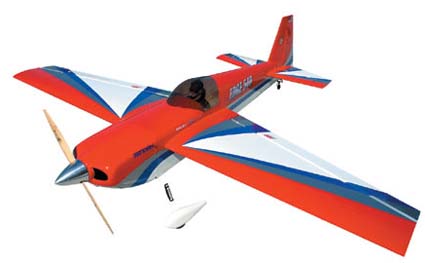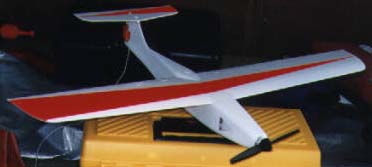What is it? How is it useful?
Which plane is "easier" to fly and land?

Hangar 9 Edge 540 33%
1730.6 sq.in.
23 lb./368 oz.
Wing loading: 30.6 oz./sq.ft

Bill Griggs Rocket
144 sq.in.
1 lb./16 oz.
Wing loading: 16 oz./sq.ft.
Which plane is "easier" to fly and land?

Hangar 9 Edge 540 33%
1730.6 sq.in.
23 lb./368 oz.
Wing loading: 30.6 oz./sq.ft

Bill Griggs Rocket
144 sq.in.
1 lb./16 oz.
Wing loading: 16 oz./sq.ft.
It is usual to compare planes using wing loading. Here are some typical thoughts about wing area.
From Keith Shaw's Talk to the EMFSO:
"For light planes, 15 - 18 oz./sq.ft., for a large one and or a small one, 12 - 15 oz./sq.ft. would be better for a nice gentle flier.
For an aerobatic or fighter aircraft, 20 - 25 oz./sq.ft. works well.
For great big airplanes you can go to 30 oz./sq.ft.
For sport flying, 20 oz./sq.ft. is a nice number for reasonable performance."
From Bob Aberle's GETTING STARTED IN BACKYARD FLYING
ULTRA-MICRO, SUB-MICRO, & MICRO: UP TO 5 OZ./SQ.FT
PARKING LOT & BACKYARD: UP TO 8 OZ./SQ.FT.
SPEED 400: 8 OZ./SQ.FT - 10 OZ./SQ.FT.
Using the above information, one might think that the 16 oz./sq.ft. plane would be the easier to fly, but is it?
Cubic wing loading (CWL), like typical wing loading, is an indicator for grouping airplanes by their possible flight characteristics. It has little to do with the aerodynamics needed to get the plane to fly at various sizes/scales in real, un-scaleable air.
The CWL indicates the relative ease of flying and skill level required to fly and land various aircraft and allows for groupings of these aircraft and even indicates the wind speed, in mph, for enjoyable flying by the everyday RC pilot.
Cubic wing loading (CWL) tries to indicate this by using a made up number. The made up number takes the two dimensional area and changes it into a "fictional" three-dimensional number.
CWL does not take into consideration the actual airfoil or aerodynamics required to get the plane to fly at a given size or scale in "real" air. It simply supplies an ease of flight number for grouping and comparing aircraft by possible flight characteristics.
Cubic Wing Loading (CWL) is usually represented in units of ounces or pounds per cubic foot.
Ounces work with our models, but can "look" a little strange when applied to full-size aircraft.
The CWL for the Hangar 9 Edge 540 33%
1730.6 sq.in. / 144 = 12 sq.ft.
The square root of 12 = 3.464 ft.
3.464 ft.^3 = 41.57 cu.ft
368 oz. / 41.57 = 8.85 oz./cu.ft (This is the CWL)
An alternate method to same result:
1730.6 sq.in. / 144 = 12 sq.ft.
12^1.5 = 41.57 cu.ft.
368 oz. / 41.57 = 8.85 oz./cu.ft (This is the CWL)
It can be seen that finding the area in sq.ft. and raising to the 1.5 is a simpler way to the same answer.
The CWL for the Bill Griggs Rocket
16 oz. weight
144 sq.in. / 144 = 1 sq.ft.
1^1.5 = 1 cu.ft.
16 oz. / 1 = 16 oz./cu.ft (This is the CWL)
It can be seen that although the Edge has a higher "wing loading", in the traditional sense, the CWL is lower by almost 50%. Given the "same" pilot skill on both planes, the pilot might say, "Wow, that Edge is a lot easier to fly than my Rocket."
In general, planes with a lower CWL are easier to fly, but they can handle less wind.
The CWL is a pretty good indicator of how much wind the plane can handle before it starts to be "not fun" but "work" to fly and land the plane.